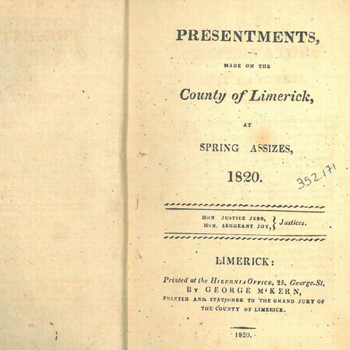
Grand Juries were the forerunners of the modern County Councils. They were a panel of major landowners in each county formed to make decisions on legal and other matters. They were originally responsible only for the justice system, but this was gradually expanded to commissioning of local public works, i.e. building of roads and bridges, and maintenance of public buildings (infirmaries, courthouses, jails etc.). It funded these works by means of a county tax on land, known as a cess or ‘rates’. They met in spring and summer, just after the regular Assizes (local court) sessions.
In these sessions, they would hear ‘presentments’, i.e. proposals for grants for the construction or maintenance of roads and bridges etc. The family history relevance is that the proposals include the names of proposed contractors. On occasion, they may also specify the work to be done by reference to the property of individuals. For example, ‘to build a bridge over the river Lingane at Maurice Shea’s house’ or ‘to repair… the mail coach road… between Timothy Duggan’s ditch and Thomas Butler’s gate, all in the townland of Ballydrihid’ (Both from Limerick GJP, 1831) The records state the names of the lead contractors, and a short specification of the work. The lead persons are local ‘gentlemen’ who may also have been Grand Jurors. The others are likely to be tradesmen with specialist skills in bridge building and other such trades.
In the collection in our Digital Library, there are two reports per year, Spring & Summer. This collection has 165 volumes, covering the years 1807 to 1900. There are a few gaps in the sequence – we have no volumes for the following years: 1809, 1831, 1833, 1836 to 1840, 1858 and 1864.
NOTE – Each volume has been scanned using OCR software, which means that it is word-searchable. However, be aware that OCR is not perfect – where the print is damaged or faded the word is unlikely to be identified. This is particularly so in the earlier volumes of this collection (up to about 1823).